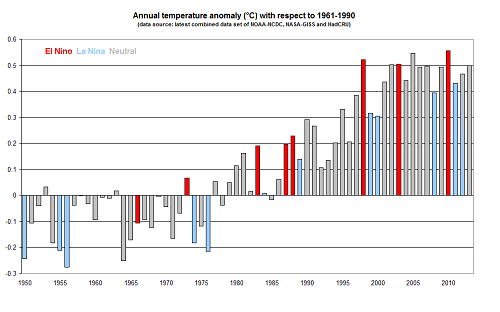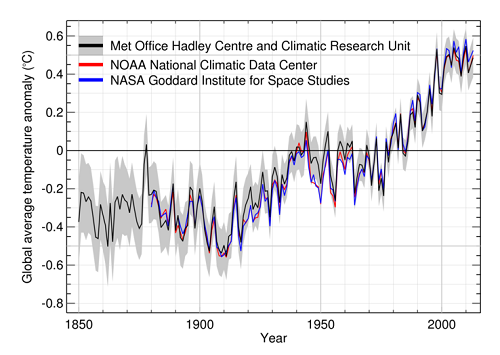2013 Among Top Ten Warmest on Record
Posted on 16 February 2014 by John Hartz
This article is a reprint of a press release posted by the World Meteorological Organization (WMO) on Feb 5, 2014.
The year 2013 was among the top ten warmest years since modern records began in 1850, according to the World Meteorological Organization (WMO). It tied with 2007 as the sixth warmest year, with a global land and ocean surface temperature that was 0.50°C (0.90°F) above the 1961–1990 average and 0.03°C (0.05°F) higher than the most recent 2001–2010 decadal average.

Thirteen of the 14 warmest years on record have all occurred in the 21st century. The warmest years on record are 2010 and 2005, with global temperatures about 0.55 °C above the long term average, followed by 1998, which also had an exceptionally strong El Niño event.
Warming El Niño events and cooling La Niña events are major drivers of the natural variability in our climate. Neither condition was present during 2013, which was warmer than 2011 or 2012, when La Niña had a cooling influence. 2013 was among the four warmest ENSO-neutral (neither El Niño nor La Niña) years on record.
“The global temperature for the year 2013 is consistent with the long term warming trend,” said WMO Secretary-General Michel Jarraud. “The rate of warming is not uniform but the underlying trend is undeniable. Given the record amounts of greenhouse gases in our atmosphere, global temperatures will continue to rise for generations to come,” said Mr Jarraud.
“Our action – or inaction – to curb emissions of carbon dioxide and other heat-trapping gases will shape the state of our planet for our children, grandchildren and great-grandchildren,” said Mr Jarraud.
Surface temperature is one of the most familiar and consistently measured weather and climate variables, and has the most direct connection to long-term climate change. But it is just part of a much wider picture. More than 90 percent of the excess heat being caused by human activities is being absorbed by the ocean.
WMO released the temperature data in advance of its full Statement on the Status of the Climate in 2013, which will be published in March 2014. This will give more extensive details of regional temperatures, precipitation, floods, droughts, tropical cyclones, ice cover and sea-level.
WMO is currently compiling information from its 191 Members about national trends and extreme events in 2013. In contrast with 2012, when the United States, in particular, observed record high annual temperatures, the warmth in 2013 was most extreme in Australia, which had its hottest year on record.
The WMO global temperature analysis is principally based on three independent complementary datasets maintained by Met Office Hadley Centre and the Climatic Research Unit, University of East Anglia, United Kingdom (combined); the National Oceanic and Atmospheric Administration (NOAA) National Climatic Data Centre; and the Goddard Institute of Space Studies (GISS) operated by the National Aeronautics and Space Administration (NASA).

Each of these datasets use slightly different methods of calculation and so each gave 2013 a different temperature ranking, but showed consistency on the inter-annual changes and the longer warming trends globally. WMO consolidates these datasets to provide single, consolidated temperature figures. WMO also uses reanalysis-based data from the European Centre for Medium-Range Weather Forecasts (ECMWF), which showed annual global land and ocean temperature to be the fourth highest on record
Across the world’s land surfaces only, the 2013 global temperature was about 0.85°C above the 1961−1990 average and about 0.06°C above the 2001−2010 average. This is the fourth warmest on record, partly due to a very warm November–December period.
With ENSO-neutral conditions prevailing, an exceptional warmth was observed in the Great Australian Bight and adjacent waters, parts of the north east and south central Pacific Ocean, and much of the Arctic Ocean and the global ocean surface temperature for 2013 was the highest since 2010. It tied with 2004 and 2006 as the sixth warmest on record, at 0.35°C above the 1961−1990 average and equal to the most recent 2001−2010 average.































 Arguments
Arguments






























Good article John. Are you going to add the first graph to your resources page? I'd find it very useful.
[JH] No. The two graphs embedded in the OP were produced by the WMO, not SkS.
Dave@1,
I second that. And it's a pity that such good, information-rich article as this one receives so little commentary attention from our fellow bloggers while the Weekly News Roundup #7 thread is going haywire feeding a troller (user-named Russel R.) who has high-jacked it to feed his strawman arguments.
It's worth noting that the global temperature data used in this WMO report may be biased low if it does not include the CW2014 correction for lack of coverage in Arctic (look at figure 2 therein and compare to to figure 1 in this article, which one do you think should go to the resources page?) Looks like data the figure 1 in this article is based on combined NCDS/GISS/HadCRUT, so it's probably less biased than HadCRUT itself, but it's still revealing to compare it to CW2014 Hybrid data where 2013 comes up warmer than 1998.